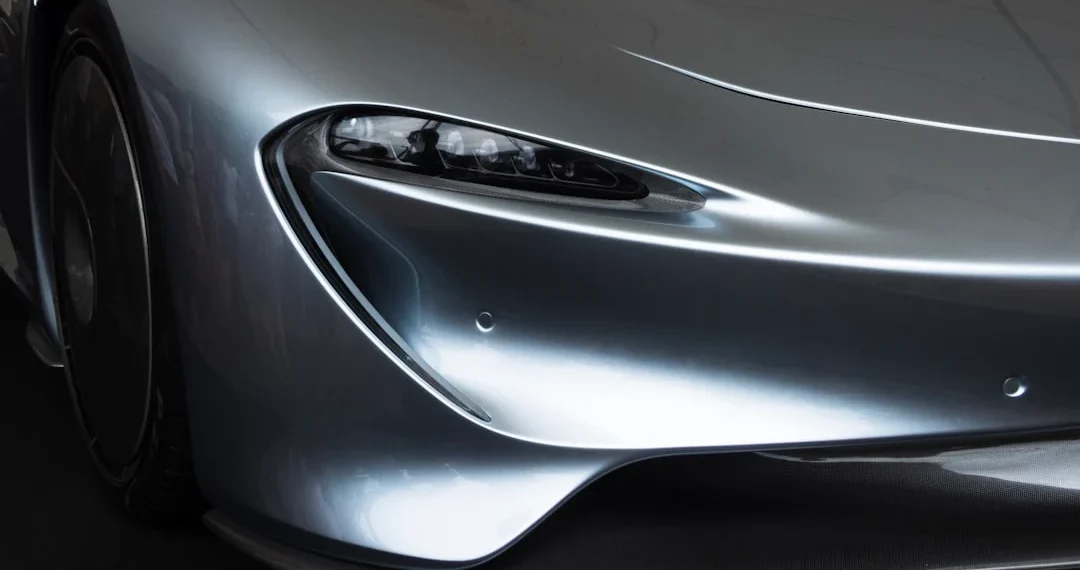The Role of Aerodynamics in Enhancing Vehicle Efficiency and Performance
Aerodynamics plays a crucial role in shaping a vehicle’s efficiency and performance by minimizing air resistance and optimizing airflow. By carefully designing the vehicle’s exterior, engineers can reduce drag, improve fuel economy, and enhance handling.
1. Reducing Drag for Better Fuel Economy
A primary goal of aerodynamic design is to reduce drag, which is the force that opposes a vehicle’s motion through the air. Lowering the drag coefficient allows the car to move more easily, requiring less energy to maintain speed. This directly translates to improved fuel economy, as the engine doesn’t have to work as hard to overcome air resistance. Smoothing out the vehicle’s shape and minimizing protrusions are key strategies for reducing drag.
2. Enhancing Stability and Handling
Aerodynamics also influences a vehicle’s stability and handling, particularly at higher speeds. By carefully managing airflow around the car, engineers can create downforce, which presses the vehicle towards the road. This increased grip enhances stability and allows for more precise handling, especially during cornering. Spoilers and diffusers are common aerodynamic devices used to generate downforce.
3. Optimizing Airflow Management
Effective aerodynamic design involves carefully managing airflow around the entire vehicle. This includes directing air to cool the engine, brakes, and other components, while also minimizing turbulence and drag. Computational Fluid Dynamics (CFD) software is widely used to simulate airflow and optimize the vehicle’s shape for maximum efficiency and performance. The placement of vents and air intakes is carefully considered to balance cooling needs with aerodynamic efficiency.
Innovations in Automotive Interior Design: Comfort and Functionality
The automotive interior is evolving beyond mere transportation, transforming into a personalized and connected space focusing on comfort and functionality. Technological advancements and shifting consumer expectations are driving these innovations.
1. Ergonomic Seating and Support Systems
Modern car interiors are increasingly prioritizing ergonomic design to enhance driver and passenger comfort, particularly on long journeys. Advanced seating systems now incorporate features like multi-way power adjustments, lumbar support, and even massage functions. Some manufacturers are exploring adaptive seating technologies that automatically adjust to the occupant’s body shape and posture, distributing pressure evenly and reducing fatigue. Furthermore, premium materials such as breathable fabrics and temperature-regulating leather contribute to a more pleasant and comfortable in-cabin experience.
2. Advanced Climate Control and Air Quality
Beyond basic heating and cooling, automotive climate control systems are becoming more sophisticated. Multi-zone climate control allows individual occupants to customize their preferred temperature settings. Advanced air filtration systems, including HEPA filters, are now common, removing allergens, pollutants, and odors from the cabin air. Some systems even incorporate sensors to monitor air quality and automatically adjust filtration levels. These innovations contribute to a healthier and more comfortable in-car environment.
3. Intuitive Interfaces and Connectivity
The integration of technology into car interiors is transforming the way drivers interact with their vehicles. Touchscreen displays are becoming larger and more prevalent, offering access to navigation, entertainment, and vehicle settings. Voice control systems are becoming more sophisticated, allowing drivers to perform tasks hands-free. Wireless smartphone integration, such as Apple CarPlay and Android Auto, is now a standard feature, providing seamless access to mobile apps and services. The focus is on creating intuitive and user-friendly interfaces that minimize driver distraction and enhance the overall driving experience.
The Science Behind Automotive Body Color: Aesthetic and Functional Considerations
Automotive body color is more than just an aesthetic choice; it involves complex chemistry, physics, and engineering considerations that impact a vehicle’s performance, safety, and longevity. The selection of color involves balancing visual appeal with functional requirements.
1. Pigments and Their Properties
Automotive paint consists of pigments, binders, solvents, and additives. Pigments provide the color and can be organic or inorganic. Inorganic pigments, like titanium dioxide, offer excellent UV resistance and durability, crucial for preventing fading. Organic pigments provide vibrant colors but may be less resistant to environmental factors. The size and shape of pigment particles also affect the paint’s gloss and metallic effects, influencing how light reflects off the surface.
2. The Physics of Color Perception
Color perception is a complex interplay of light, the paint’s surface, and the human eye. When light strikes a car’s surface, certain wavelengths are absorbed, and others are reflected. The reflected wavelengths determine the color we perceive. Metallic paints contain aluminum flakes that reflect light, creating a shimmering effect. The angle at which light hits the surface and the observer’s viewpoint also affect the perceived color, a phenomenon known as metamerism.
3. Functional Implications of Color Choice
A car’s color can influence its temperature, visibility, and even resale value. Darker colors absorb more heat, increasing the interior temperature and potentially impacting fuel efficiency due to increased air conditioning use. Lighter colors reflect more light, making the car more visible to other drivers, potentially reducing accidents. Studies also suggest that certain colors are more prone to bird droppings due to avian visual perception.
Seating Layouts: Balancing Space, Comfort, and Safety in Modern Cars
Modern car seating layouts represent a complex interplay of maximizing interior space, ensuring passenger comfort, and adhering to stringent safety standards. Automakers continuously innovate to optimize seating arrangements for diverse needs.
1. The Evolution of Seating Configurations
Early automobiles often featured simple bench seats, but today’s vehicles offer a variety of configurations. From the standard two-row, five-passenger setup to three-row SUVs accommodating seven or eight occupants, the evolution has been driven by consumer demand for increased capacity and versatility. Minivans, for example, popularized captain’s chairs in the second row, offering enhanced comfort and individual space. This shift reflects a broader trend towards prioritizing passenger experience and adapting to different family sizes and lifestyles.
2. Optimizing Space with Innovative Designs
Carmakers employ various strategies to maximize interior space within a vehicle’s footprint. Slimmer seat designs, often utilizing advanced materials and ergonomic principles, contribute to increased legroom and overall cabin spaciousness. Features like sliding and reclining seats, particularly in the second and third rows, further enhance flexibility, allowing passengers to customize their seating positions for optimal comfort. These design choices are crucial for creating a pleasant and practical driving experience, especially on long journeys.
3. Safety Considerations in Seating Design
Seating design is intrinsically linked to safety. Seats must provide adequate support and restraint during collisions to minimize injuries. Integrated headrests, side bolsters, and optimally positioned seatbelts are essential safety features. Moreover, the placement and design of seats influence the effectiveness of airbags and other safety systems. Rigorous testing and adherence to safety regulations are paramount in ensuring that seating layouts contribute to overall vehicle safety performance.
Lighting Design in Automobiles: From Illumination to Communication
Automobile lighting has evolved beyond mere visibility, transforming into a critical element of vehicle aesthetics, safety, and communication with other road users. Modern lighting systems leverage advanced technologies to achieve optimal performance and visual appeal.
1. The Evolution of Headlight Technology
Early automobiles relied on simple acetylene or oil lamps for illumination. These were gradually replaced by incandescent bulbs, which offered improved brightness and ease of use. Halogen lamps became popular for their increased light output and longer lifespan. Today, Light Emitting Diodes (LEDs) are the dominant technology, offering superior energy efficiency, compact size, and design flexibility. Laser headlights, offering even greater range and intensity, are also emerging in high-end vehicles.
2. The Role of Daytime Running Lights (DRLs)
Daytime Running Lights (DRLs) significantly enhance vehicle visibility during daylight hours, reducing the risk of accidents. Studies have shown that vehicles equipped with DRLs are more easily detected by other drivers and pedestrians. Modern DRLs often utilize LED technology to create distinctive and eye-catching designs, contributing to brand identity. Regulations regarding DRLs vary across different countries, with many requiring them on all new vehicles.
3. Advanced Driver-Assistance Systems (ADAS) Integration
Automobile lighting is increasingly integrated with Advanced Driver-Assistance Systems (ADAS). Adaptive Driving Beam (ADB) technology automatically adjusts headlight beams to avoid blinding oncoming traffic while maximizing illumination of the road ahead. Camera-based systems can detect pedestrians or cyclists and direct light towards them, enhancing safety. These advanced lighting features contribute to a more comfortable and secure driving experience.
Dashboard Evolution: Integrating Technology for a Seamless Driving Experience
The dashboard has transformed from a simple gauge cluster to a central hub, integrating technology for enhanced safety, convenience, and driver engagement. Modern dashboards prioritize seamless interaction and intuitive design.
1. The Rise of Digital Instrument Clusters
Digital instrument clusters are replacing traditional analog gauges, offering drivers customizable displays with information like speed, fuel level, navigation, and advanced driver-assistance systems (ADAS) alerts. These clusters enhance readability and reduce driver distraction by presenting only essential information at a glance. Some 2024 models feature curved displays that improve viewing angles and reduce glare.
2. Infotainment System Integration
Modern dashboards seamlessly integrate infotainment systems, providing access to navigation, entertainment, and vehicle settings. Touchscreen displays have become increasingly common, with many systems supporting voice control and smartphone integration via Apple CarPlay and Android Auto. The trend is moving towards larger, higher-resolution displays with improved responsiveness and user interfaces.
3. Head-Up Displays (HUDs)
Head-Up Displays (HUDs) project crucial information onto the windshield, allowing drivers to keep their eyes on the road. HUDs can display speed, navigation directions, ADAS warnings, and other relevant data. Advanced HUDs even utilize augmented reality (AR) to overlay information onto the real-world view, further enhancing situational awareness and safety.
Q&A
Question 1: How does aerodynamics contribute to enhanced vehicle stability and handling?
Answer: Aerodynamic design manages airflow to create downforce, pressing the vehicle towards the road. This increased grip improves stability and handling, particularly at higher speeds and during cornering. Spoilers and diffusers are common aerodynamic devices used to generate this downforce.
Question 2: Beyond fuel efficiency and handling, what other aspects of vehicle design are influenced by aerodynamics?
Answer: Aerodynamic design also influences airflow management around the entire vehicle. This includes directing air to cool the engine and brakes while minimizing turbulence and drag. Computational Fluid Dynamics (CFD) software helps optimize the placement of vents and air intakes to balance cooling needs with aerodynamic efficiency.
Question 3: What are some examples of innovations in automotive interior design focused on enhancing comfort and functionality?
Answer: Innovations include ergonomic seating with features like power adjustments, lumbar support, and massage functions; advanced climate control with multi-zone temperature settings and HEPA filtration; intuitive interfaces with larger touchscreens, voice control, and smartphone integration; and flexible cabin spaces with modular seating and adaptable cargo areas.
References:
- https://www.epicflow.com/blog/5-latest-trends-in-the-automotive-industry/
- https://www.caranddriver.com/news/g64457986/bestselling-cars-2025/
- https://automotiveinteriors-expo-usa.com
- https://www.jdpower.com/business/press-releases/2025-us-initial-quality-study-iqs
- https://www.caranddriver.com/news/






